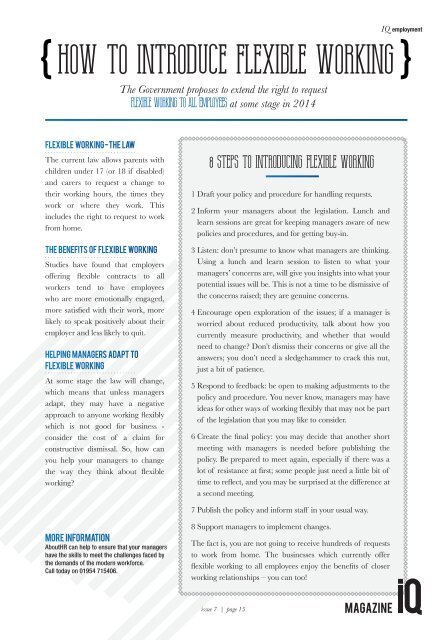IQ-Magazine-Issue-7
You also want an ePaper? Increase the reach of your titles
YUMPU automatically turns print PDFs into web optimized ePapers that Google loves.
HOW TO INTRODUCE FLEXIBLE WORKING<br />
The Government proposes to extend the right to request<br />
Flexible working to all employees at some stage in 2014<br />
<strong>IQ</strong> employment<br />
Flexible Working - The Law<br />
The current law allows parents with<br />
children under 17 (or 18 if disabled)<br />
and carers to request a change to<br />
their working hours, the times they<br />
work or where they work. This<br />
includes the right to request to work<br />
from home.<br />
The Benefits of Flexible Working<br />
Studies have found that employers<br />
offering flexible contracts to all<br />
workers tend to have employees<br />
who are more emotionally engaged,<br />
more satisfied with their work, more<br />
likely to speak positively about their<br />
employer and less likely to quit.<br />
Helping Managers Adapt to<br />
Flexible Working<br />
At some stage the law will change,<br />
which means that unless managers<br />
adapt, they may have a negative<br />
approach to anyone working flexibly<br />
which is not good for business -<br />
consider the cost of a claim for<br />
constructive dismissal. So, how can<br />
you help your managers to change<br />
the way they think about flexible<br />
working?<br />
8 STEPS TO INTRODUCING FLEXIBLE WORKING<br />
1 Draft your policy and procedure for handling requests.<br />
2 Inform your managers about the legislation. Lunch and<br />
learn sessions are great for keeping managers aware of new<br />
policies and procedures, and for getting buy-in.<br />
3 Listen: don’t presume to know what managers are thinking.<br />
Using a lunch and learn session to listen to what your<br />
managers’ concerns are, will give you insights into what your<br />
potential issues will be. This is not a time to be dismissive of<br />
the concerns raised; they are genuine concerns.<br />
4 Encourage open exploration of the issues; if a manager is<br />
worried about reduced productivity, talk about how you<br />
currently measure productivity, and whether that would<br />
need to change? Don’t dismiss their concerns or give all the<br />
answers; you don’t need a sledgehammer to crack this nut,<br />
just a bit of patience.<br />
5 Respond to feedback: be open to making adjustments to the<br />
policy and procedure. You never know, managers may have<br />
ideas for other ways of working flexibly that may not be part<br />
of the legislation that you may like to consider.<br />
6 Create the final policy: you may decide that another short<br />
meeting with managers is needed before publishing the<br />
policy. Be prepared to meet again, especially if there was a<br />
lot of resistance at first; some people just need a little bit of<br />
time to reflect, and you may be surprised at the difference at<br />
a second meeting.<br />
7 Publish the policy and inform staff in your usual way.<br />
more information<br />
AboutHR can help to ensure that your managers<br />
have the skills to meet the challenges faced by<br />
the demands of the modern workforce.<br />
Call today on 01954 715406.<br />
8 Support managers to implement changes.<br />
The fact is, you are not going to receive hundreds of requests<br />
to work from home. The businesses which currently offer<br />
flexible working to all employees enjoy the benefits of closer<br />
working relationships – you can too!<br />
issue 7 | page 15

















